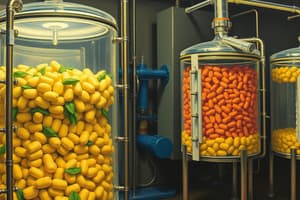Podcast
Questions and Answers
Explain the difference between solid state and submerged bioreactor systems in terms of water content and examples of microorganisms used in each.
Explain the difference between solid state and submerged bioreactor systems in terms of water content and examples of microorganisms used in each.
Solid state bioreactor systems have a water content of 40-80% and are mostly used for mold fermentation on agriculture products and food like rice. Submerged bioreactor systems have a water content greater than 95% and are used for microorganisms like bacteria and yeast.
What are the criteria for classifying bioreactors according to the type and form of biocatalyst and the mode of operation?
What are the criteria for classifying bioreactors according to the type and form of biocatalyst and the mode of operation?
Bioreactors can be classified based on the type and form of biocatalyst, such as free cells in submerged cultures or carried bound/immobilized cells/enzymes, and based on the mode of operation, which can be batch, continuous, or fed-batch.
Why is the bioreactor often described as the heart of a bioprocess?
Why is the bioreactor often described as the heart of a bioprocess?
The bioreactor is described as the heart of a bioprocess because it is the container in which substrate is converted into the product by the action of biocatalyst, and it is where the actual conversion occurs.
What is the function of a bioreactor in a bioprocess?
What is the function of a bioreactor in a bioprocess?
How can bioreactors be classified according to the type and form of biocatalyst?
How can bioreactors be classified according to the type and form of biocatalyst?
What are the different modes of operation for bioreactors?
What are the different modes of operation for bioreactors?
What are the two types of agitators used in bioreactors and how are they classified based on flow?
What are the two types of agitators used in bioreactors and how are they classified based on flow?
How is foam typically controlled in bioreactors and what issues can excessive foam formation lead to?
How is foam typically controlled in bioreactors and what issues can excessive foam formation lead to?
Flashcards are hidden until you start studying
Study Notes
Bioreactor Systems
- Solid state bioreactors have minimal water content, whereas submerged bioreactors have a high water content, allowing for the growth of microorganisms such as fungi, bacteria, and yeast.
- Examples of microorganisms used in solid state bioreactors include Aspergillus, Penicillium, and Rhizopus, while submerged bioreactors often use microorganisms like E. coli, Saccharomyces, and Bacillus.
Classification of Bioreactors
- Bioreactors can be classified according to the type and form of biocatalyst, such as free or immobilized enzymes, whole cells, or organelles.
- Mode of operation is another classification criterion, which includes batch, fed-batch, continuous, and perfusion.
Bioreactor in Bioprocess
- The bioreactor is often referred to as the heart of a bioprocess because it is the vessel where the biocatalyst performs the desired biochemical reaction.
- The primary function of a bioreactor is to provide a controlled environment for the biocatalyst to convert substrates into products.
Classification of Bioreactors by Biocatalyst
- Bioreactors can be classified into three types based on the biocatalyst: enzymatic bioreactors, microbial bioreactors, and cell culture bioreactors.
Modes of Operation
- Bioreactors can operate in different modes, including batch, fed-batch, continuous, and perfusion, each with its own advantages and disadvantages.
Agitators in Bioreactors
- There are two types of agitators used in bioreactors: mechanical agitators (e.g., impellers, turbines) and pneumatic agitators (e.g., air-lift, bubble column).
- Agitators are classified based on flow, either laminar or turbulent, which affects the mixing and oxygen transfer in the bioreactor.
Foam Control in Bioreactors
- Foam is typically controlled in bioreactors using antifoaming agents, skimmers, or mechanical foam breakers.
- Excessive foam formation can lead to issues such as reduced oxygen transfer, clogged filters, and increased risk of contamination.
Studying That Suits You
Use AI to generate personalized quizzes and flashcards to suit your learning preferences.




